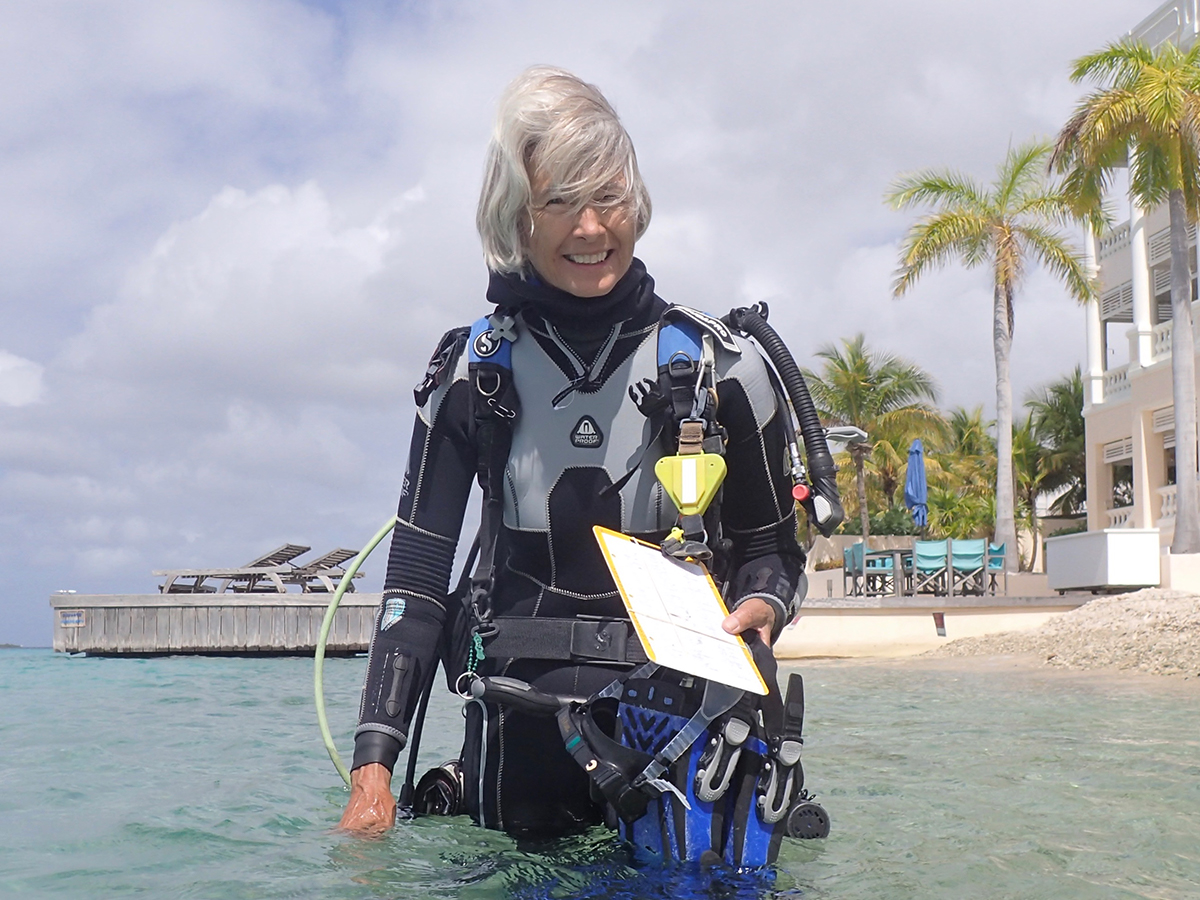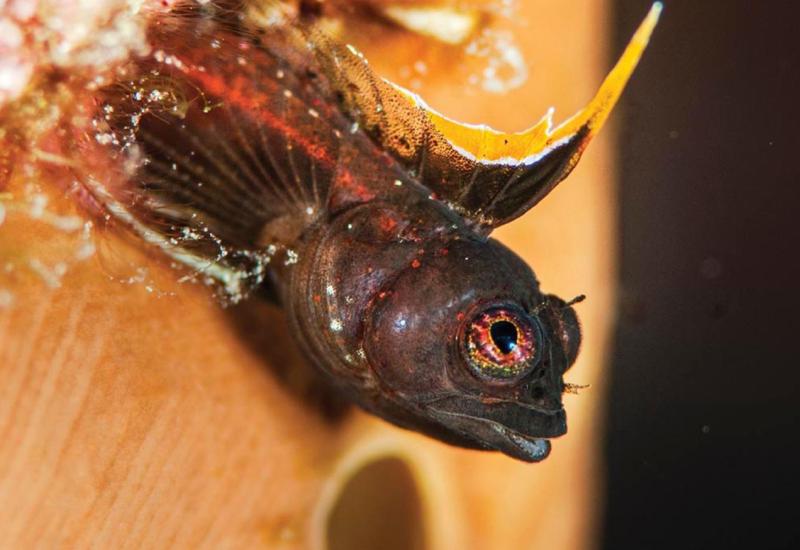Divers Guide to Bonaire
With all of the shore diving in Bonaire, there’s no such thing as oversleeping and missing the dive. Go ahead and stay up late and sleep in. Or get up early for a sunrise dive. The action is nonstop, if you want it to be, and it happens on your schedule.
Tina Wall, a longtime instructor at Buddy Dive Resort, finds that the independent spirit of Bonaire surprises divers. “They come away saying, ‘Wow, I just did whatever I wanted all week long!’ — and isn’t that what vacation is all about?”
If you choose to dive some of the healthiest reefs in the Caribbean from the comfort of the boat, know that the satellite isle of Klein Bonaire adds even more dives to the menu. The options are endless. So stop worrying about FOMO and get out there and dive — however you want.
Best Scuba Diving in Bonaire

Shutterstock.com/Kate IngleYellow stones make shore-entry dive sites easy to spot all around the island.
1,000 Steps
Park It: At the entrance for the radio towers, there's a small parking lot just across the street from the winding staircase (there are actually only about 64 steps) that leads down to the cove.
Get In: The easiest entry is from a small sandy patch south of the small bay.
Dive It: On the reef slope, you'll find small shoals of reef fish like parrotfish, doctorfish and gray angels, healthy purple tube sponges and numerous cleaning stations. Depths range from 15 feet to more than 130.
Fun Fact: Bari Reef’s collection of 361 fish species is the most diverse array in the entire Caribbean, according to the Reef Environmental Education Foundation.
Karpata
Park It: Located just before the restricted reserve in the northwest corner of the island, Karpata's parking lot overlooks the site.
Get In: There are fewer steps (about 50) carved into the cliff at Karpata than at 1,000 Steps. You'll wade in next to the concrete pier, and follow it until you can float out to the reef.
Dive It: This site features wall-like formations--unusual for Bonaire--with rolling slopes and sand chutes that lead down to 120 feet. The reef is shingled at 60 feet with sheet coral, and squadrons of chromis are usually found here. Karpata has become very popular because turtles are commonly spotted.
Witches Hut/Weber's Joy
Park It: Park across the street from the stone path.
Get In: An easy entry down a stone path that leads to the water's edge. Sometimes there's a strong surface current and challenging surf.
Dive It: You'll find stony corals that look like oversized pillows and giant mushrooms in relatively shallow depths. Look for good-sized green morays hiding underneath coral ledges and cleaner shrimp on purple-tipped anemones. Depths range from 25 feet to 125.
Jeff Davis Memorial
Park It: Park across the street from the path.
Get In: A short walk down a hiking path to a rocky beach. You can either leave your gear on the ledge, hop down, and then gear up and swim out or make your entry at the sandy patch to the right. Like Witches Hut, there can be a fairly stiff surface current running.
Dive It: The shallows feature hordes of chromis. You can follow some sand chutes to the bottom at 125 feet, but the best stuff, including barracudas, is in the 45- to 75-foot range.
Angel City
Park It: The yellow rock at this site is at the turn-off for parking.
Get In: An easy shore entry, but it's a slightly long swim out to the drop-off.
Dive It: One of the best examples of the double reef system, Angel City is between Alice in Wonderland and Hilma Hooker. Head down the reef to where the sand appears in about 60 feet of water; swim across to the outer reef, which falls away into the blue. The site gets its name from the ubiquitous angelfish found here, but there's plenty more to see.
Hilma Hooker

Shutterstock.com/aquapixA diver explores the Hilma Hooker.
Park It: The parking lot is adjacent to the beach.
Get In: Go early in the morning to avoid the crowds at this very popular site.
Dive It: The 235-foot Hilma Hooker is Bonaire's biggest wreck, a steel-hulled freighter resting on its starboard side with a shady past (25,000 pounds of marijuana was found in a false bulkhead after the ship had engine problems and was towed to Kralendijk). There are three buoys on the wreck--one is on the reef at 20 feet, one on the bow at 80 feet, and the third on the stern at 65 feet. As long as the water is calm, snorkel out to one of them and then drop down on the wreck. The purple tube sponges on the bridge are prolific; look for sergeant majors guarding their eggs here.
White Slave
Park It: The parking is south of the white cement huts.
Get In: The beach is coral rubble, so watch your footing. The swim to the drop-off is a bit long; make sure you have enough air for the way back in case you encounter current.
Dive It: The drop-off starts in about 30 feet of water, and then slopes down to 125. Coral and sponges thrive on the slope, including huge purple tube sponges. Butterflyfish, triggers and angels flit about the reef in about 50 feet of water.
Red Slave
Park It: Turn at the yellow BNMP rock and park near the huts.
Get In: The bottom is rocky at the entry point, so you'll want to get underwater fairly quickly. The current can be very strong.
Dive It: A sandy plain swarms with razorfish and sennets; at the drop-off at about 40 feet, currents have shaped barrel sponges into flat discs. Large schools of fish, including French grunts and yellow goatfish, are found between 50 and 85 feet. Keep an eye out for turtles.
Plaza Resort/18th Palm:
Get In: Walk in off the small sand beach, swim to the buoy, then drop down.
Dive It: There are small terraces of scattered coral heads, tube sponges, elephant ear sponge and gardens of anemones.
Klein Bonaire
You'll need to board a boat to dive Klein Bonaire, a small, uninhabited island located three-quarters of a mile off Bonaire's west coast, but the trip pays off as these pristine sites are legendary. Most of the island is a protected reserve and sea turtle hatchery, though beach lovers can spend some time on Playa Neme off the northwest coast.
Ebo's Special
Get In: Boat dive, northwest coast.
Skill Level: Novice to advanced.
Dive It: There's practically no shallow terrace on the northwest corner of Klein, just a continual downward slope. At about 60 feet, look for a small cave along the slope where you might find a sleeping nurse shark. If you've got a keen eye for fish behavior, you'll encounter cleaning stations where chromis and parrotfish hang out. Turtles are frequently sighted; most nesting activity takes place between June and September. This site, which is also known as Jerry's Jam, starts in water as shallow as 20 feet and drops down to 120.

Jennifer PennerBonaire’s national marine park is among the best in the world. The payoff for divers? Healthy reefs that are jampacked with tropical reef fish.
Sharon's Serenity
Get In: Boat dive, southwest coast.
Skill Level: Novice to advanced.
Dive It: Beginners can find lots to explore on the calm, shallow shelf that is loaded with marine life, including reef tropicals like angelfish and sergeant majors. But more advanced divers will be seduced deeper: the reef drops off, with massive domes of mountainous star corals giving way to terraces of plate and star corals. There's a great variety of fish life here, including aggregations of bogas, yellow goatfish and midnight parrotfish. Depths range from 30 feet to more than 130, so keep an eye on your computer.
How to Get Around Bonaire
A car rental — often included with resort packages — allows divers to maximize the flexibility offered by the plethora of shore sites and 24-hour access. (Every license plate reads “Divers paradise!”)
Free maps at the airport guide you to every named site on the island, but it’s easy to find the entrances to Bonaire’s many shore dives, even if you’re a first-timer. Each is marked with a good-size stone painted yellow, with the dive-site name printed in black — a uniquely Bonairean system that makes navigation a cinch. Plus, with just one major road encircling the 111-square-mile island, it’s practically impossible to get lost.
Buddy Dive Resort has a drive-through tank-filling station where you can swing through to trade out empty tanks for full ones.
Need to Know

Shutterstock.com/Anna KrasnopeevaDivers wade into Bachelor Beach.
Best Time to Dive Bonaire: Year-round
Bonaire Dive Conditions: The water is 78 to 82°F. Visibility is 60 feet or greater.
Recommended Dive Equipment: A 3 mm suit typically will suffice, or even just a swimsuit and rash guard
Language: Officially Dutch, but everyone also speaks English.
Currency: U.S. dollar.
Main Airport: BON, Flamingo International Airport near Kralendijk.
Travel Tip: Most flights leave and depart on Saturday, so plan accordingly.
More Information: ScubaDiving.com/Bonaire











